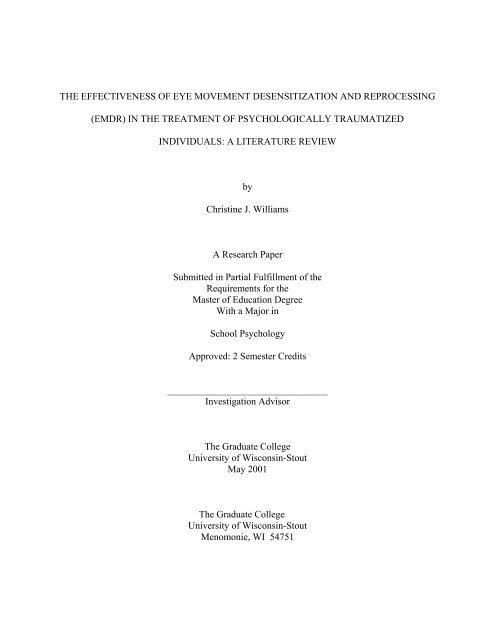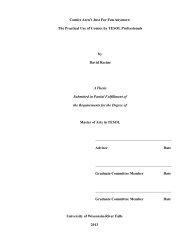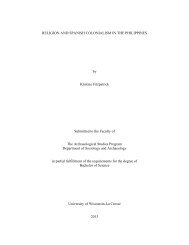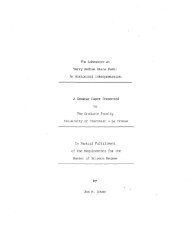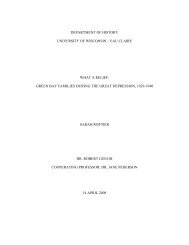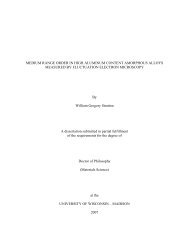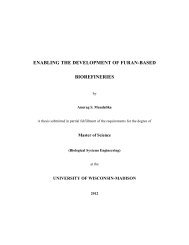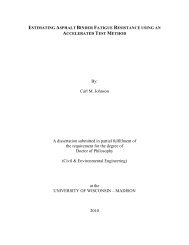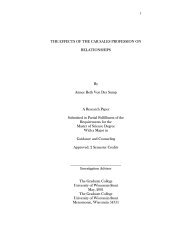The effectiveness of eye movement desensitization and reprocessing
The effectiveness of eye movement desensitization and reprocessing
The effectiveness of eye movement desensitization and reprocessing
You also want an ePaper? Increase the reach of your titles
YUMPU automatically turns print PDFs into web optimized ePapers that Google loves.
THE EFFECTIVENESS OF EYE MOVEMENT DESENSITIZATION AND REPROCESSING<br />
(EMDR) IN THE TREATMENT OF PSYCHOLOGICALLY TRAUMATIZED<br />
INDIVIDUALS: A LITERATURE REVIEW<br />
by<br />
Christine J. Williams<br />
A Research Paper<br />
Submitted in Partial Fulfillment <strong>of</strong> the<br />
Requirements for the<br />
Master <strong>of</strong> Education Degree<br />
With a Major in<br />
School Psychology<br />
Approved: 2 Semester Credits<br />
_________________________________<br />
Investigation Advisor<br />
<strong>The</strong> Graduate College<br />
University <strong>of</strong> Wisconsin-Stout<br />
May 2001<br />
<strong>The</strong> Graduate College<br />
University <strong>of</strong> Wisconsin-Stout<br />
Menomonie, WI 54751
ABSTRACT<br />
Williams Christine J.<br />
Eye Movement 2<br />
(Last Name) (First) (Initial)<br />
<strong>The</strong> Effectiveness <strong>of</strong> Eye Movement Desensitization <strong>and</strong> Reprocessing in the Treatment <strong>of</strong><br />
Psychologically Traumatized Individuals: A Literature Review<br />
(Title)<br />
School Psychology Dr. Helen Swanson May, 2001 36<br />
(Graduate Major) (Research Advisor) (Month/Year) (No <strong>of</strong> Pages)<br />
Publication Manual <strong>of</strong> the American Psychological Association, Fourth Edition<br />
(Name <strong>of</strong> Style Manual Used in this Study)<br />
<strong>The</strong> purpose <strong>of</strong> this literature review was to investigate the <strong>effectiveness</strong> <strong>of</strong> Eye<br />
Movement Desensitization <strong>and</strong> Reprocessing (EMDR) with traumatized individuals primarily<br />
diagnosed with Post Traumatic Stress Disorder (PTSD). In this investigation an overview <strong>of</strong> Eye<br />
Movement Desensitization <strong>and</strong> Reprocessing (EMDR) as well as other approaches in the<br />
treatment <strong>of</strong> traumatized individuals was explored. Included in this investigation is a critical<br />
review <strong>of</strong> controlled research <strong>and</strong> the use <strong>of</strong> EMDR. Finally, the information is summarized <strong>and</strong><br />
recommendations are <strong>of</strong>fered based upon information gathered.
Acknowledgements<br />
Eye Movement 3<br />
<strong>The</strong> author wishes to thank Dr. Helen Swanson for acting as my advisor in the process <strong>of</strong><br />
writing this thesis. Her guidance <strong>and</strong> expertise in pr<strong>of</strong>essional writing was most helpful. I<br />
would also like to thank the University <strong>of</strong> Wisconsin-Stout for allowing me the opportunity to<br />
advance my education. Thank you to my friend Jason Hlasny for his support <strong>and</strong> assistance with<br />
editing <strong>and</strong> formatting. In addition, I want to thank my four children for their love,<br />
encouragement, <strong>and</strong> patience in the process <strong>of</strong> writing my thesis.
Table <strong>of</strong> Contents<br />
Eye Movement 4<br />
Chapter I: Introduction...................................................................................................................5<br />
Research Intentions..............................................................................................................8<br />
Method for Selecting Subjects.............................................................................................8<br />
Conducting EMDR ..............................................................................................................9<br />
Evaluating Treatment...........................................................................................................9<br />
Definition <strong>of</strong> Terms............................................................................................................10<br />
Chapter II: Literature Review......................................................................................................11<br />
PTSD Overview.................................................................................................................11<br />
EMDR Overview ...............................................................................................................12<br />
Treatment <strong>of</strong> PTSD............................................................................................................15<br />
<strong>The</strong>oretical Framework......................................................................................................16<br />
Review <strong>of</strong> Studies on the Effectiveness <strong>of</strong> EMDR with PTSD.........................................17<br />
Chapter III: Critical Analysis <strong>of</strong> Research..................................................................................22<br />
Research............................................................................................................................22<br />
Summary <strong>of</strong> Findings........................................................................................................24<br />
Conclusions.......................................................................................................................26<br />
Recommendations for Future Research............................................................................27<br />
References.........................................................................................................................28
CHAPTER I<br />
Introduction<br />
Eye Movement 5<br />
Today, people are faced with many challenges in their everyday lives. <strong>The</strong>se challenges<br />
may come in the form <strong>of</strong> a natural disaster, personal assault, or terrorism. An example <strong>of</strong> how<br />
trauma can enter our everyday life is in the 1999 tragedy at Columbine High School. At<br />
approximately 11:30 am on Tuesday, April 20, 1999 two students dressed in black trench coats<br />
with black masks entered Columbine High School in Littleton, Colorado with shot guns,<br />
grenades, <strong>and</strong> home made bombs <strong>and</strong> proceeded to open fire on anything <strong>and</strong> everyone that<br />
moved. This tragedy continued to claim lives even after the initial incident, when a mother<br />
killed herself because she could not bear the pain <strong>of</strong> losing her child. Another example <strong>of</strong> how<br />
lives can be lost <strong>and</strong> changed forever is the Oklahoma City bombing disaster. On April 19,<br />
1995, Timothy McVeigh carried out a terrorist attack on a federal building that left 168 people<br />
dead. On that same day, due to the bombing, a search <strong>and</strong> rescue operation began <strong>and</strong> continued<br />
for fourteen days. <strong>The</strong>se <strong>and</strong> other events can continue to cause psychological distress long after<br />
the initial event.<br />
After a trauma that confronts an individual with their vulnerability, life can never be truly<br />
the same. Sorting out exactly what happened <strong>and</strong> sharing their reactions with others can make a<br />
great deal <strong>of</strong> difference in the individual’s adaptation to the event. For many, the traumatic<br />
experience will somehow be integrated as part <strong>of</strong> the person’s life. Others may be at risk for<br />
developing Post Traumatic Stress Disorder (PTSD).<br />
Results <strong>of</strong> the National Comorbidity Survey (NCS), reported by Kessler (1995), suggests<br />
that 60.7% <strong>of</strong> men <strong>and</strong> 51.2% <strong>of</strong> women reported experiencing at least one traumatic event in
Eye Movement 6<br />
their lifetime. Of those experiencing a trauma, nearly eight percent develop PTSD, with women<br />
twice as likely as men to develop symptoms at some point in their lives. <strong>The</strong> most frequently<br />
experienced traumas reported were: witnessing someone being badly injured or killed; being<br />
involved in a fire; flood, or natural disaster; being involved in a life-threatening accident; <strong>and</strong><br />
combat exposure. Further, PTSD is <strong>of</strong>ten a lifetime disorder that can persist for years.<br />
<strong>The</strong> prevalence <strong>of</strong> PTSD among the American population highlights the critical need for<br />
mental health providers to be aware <strong>of</strong> effective treatments for this disorder. Several traditional<br />
methods <strong>of</strong> treating PTSD exist, including: flooding; narrative therapy; psychotherapy; hypnosis;<br />
<strong>and</strong> drug therapy. In addition, a more recently developed intervention, Eye Movement<br />
Desensitization <strong>and</strong> Reprocessing (EMDR; Shapiro, 1989) is being used more <strong>and</strong> more<br />
frequently in the treatment <strong>of</strong> PTSD. EMDR is a new therapeutic treatment in which the client<br />
engages in rapid <strong>eye</strong> <strong>movement</strong>s while focusing on a disturbing memory, feeling, image, or body<br />
sensation associated with a past traumatic event. <strong>The</strong> process is thought to allow the client to<br />
access repressed memories <strong>and</strong> feelings, which he or she may have not been able to remember,<br />
discuss, or therapeutically process. Thus, proponents <strong>of</strong> the approach believe EMDR can<br />
potentially allow individuals with PTSD to “reprocess” traumatic events in a therapeutically<br />
healthy way. Further, EMDR is thought to facilitate this process rather dramatically by<br />
removing excessive fear <strong>and</strong> emotional anxiety surrounding a past trauma. As a result, the<br />
individual can regard it as a memory with little or no associated negative emotions.<br />
In general, there appears to be a lack <strong>of</strong> clinical outcome research on the <strong>effectiveness</strong> <strong>of</strong><br />
traditional methods for treating PTSD. <strong>The</strong> disorder was <strong>of</strong>ficially recognized <strong>and</strong> classified in<br />
the 1980 Diagnostic <strong>and</strong> Statistical Manual <strong>of</strong> Mental Disorders (DSM-III), yet thirteen years
Eye Movement 7<br />
later only six r<strong>and</strong>omized clinical outcome studies were to be found in the published literature<br />
(Solmon, Gerrity, & Muff (1992), <strong>and</strong> four <strong>of</strong> these studies were limited to subject specific<br />
samples <strong>of</strong> male Vietnam combat veterans. However, proponents <strong>of</strong> EMDR have made claims<br />
about its <strong>effectiveness</strong>.<br />
Shapiro (1995) reports that EMDR has had more published case reports <strong>and</strong> controlled<br />
outcome research to support it than any other method currently used in the treatment <strong>of</strong> PTSD<br />
<strong>and</strong> over 30,000 clinicians have been trained worldwide. Indeed, case reports claim to support<br />
EMDR as an effective treatment for traumatic memories (Kleinknecht & Morgan, 1992; Loevin,<br />
1993; Lipke & Botkin, 1992; Marquis, 1991; McCann, 1992; Page & Crino, 1993; Wernick,<br />
1993; Wolpe & Abrams, 1991). Independent reviewers also recently placed EMDR on a list <strong>of</strong><br />
treatments deemed “probably efficacious for civilian PTSD” as were exposure therapy (e.g.,<br />
flooding) <strong>and</strong> stress inoculation therapy (Chambless, Baker, Baucom, Beutler, Calhoun, Crits,<br />
Daiuto, DeRubeis, Detweiler, Haaga, Bennett Johnson, McCury, Mueser, Pope, S<strong>and</strong>erson,<br />
Shoham, Stickle, Williams, & Woody, 1998). Wilson <strong>and</strong> Tinker (1995) has also concluded that<br />
while much support for EMDR exists in case reports, research is needed to empirically evaluate<br />
the treatment.<br />
<strong>The</strong> question that needs to be addressed is, has EMDR been studied empirically or are<br />
therapists getting caught up in the wondrous cures that it may provide? Even more important is<br />
whether clinicians are relying on research data <strong>and</strong> critiquing the quality <strong>of</strong> the research that has<br />
been done when making decisions with regard to the treatment <strong>of</strong> their patients. It is <strong>of</strong> utmost<br />
importance for mental health providers to make therapeutic decisions that are well grounded in<br />
research such that the best interests <strong>of</strong> the patient are at the forefront.
Research Intentions<br />
Eye Movement 8<br />
Given the need for further investigation on the <strong>effectiveness</strong> <strong>of</strong> EMDR as a therapeutic<br />
treatment for individuals diagnosed with PTSD, the purpose <strong>of</strong> this study is to review empirical<br />
research on the <strong>effectiveness</strong> <strong>of</strong> EMDR for individuals diagnosed with PTSD. <strong>The</strong> review<br />
specifically addresses current research issues in making decisions regarding treatment<br />
<strong>effectiveness</strong>. <strong>The</strong> issues to be discussed include: methods for selecting subjects; consistency in<br />
conducting EMDR; <strong>and</strong> methods for evaluating treatment <strong>effectiveness</strong>. A critical analysis <strong>of</strong><br />
the findings <strong>and</strong> conclusions regarding EMDR <strong>effectiveness</strong> are presented. Recommendations<br />
for future research are also discussed.<br />
Method for Selecting Subjects<br />
In the selection <strong>of</strong> studies, the researcher noted critical characteristics <strong>of</strong> the subjects<br />
involved. In the case <strong>of</strong> war veterans, secondary gain was an issue due to the possibility <strong>of</strong> the<br />
subject losing their disability check if their PTSD was cured. <strong>The</strong>refore, studies <strong>of</strong> these subjects<br />
were not included in the present investigation. Two other criteria used in the elimination <strong>of</strong><br />
subjects studied were whether dual diagnosis or active drug use were present in the subjects.<br />
Thus, the researcher took into consideration whether or not the groups studied were<br />
representative <strong>of</strong> the population as a whole. This is imperative for the research outcome to have<br />
significant meaning <strong>and</strong> for the results to be generalizable to similar clientele (Shapiro, 1995).<br />
Individuals diagnosed with PTSD can vary greatly with regard to whether or not the individual is<br />
actively using drugs, has a dual diagnosis, has suffered one or several traumatic experiences, or<br />
has secondary gain issues such as compensation for their disability. Thus, simply stating that<br />
EMDR is effective for the treatment <strong>of</strong> PTSD is meaningless without information that the
Eye Movement 9<br />
intervention is effective with individuals who have diverse symptomology or other areas <strong>of</strong><br />
difficulty.<br />
Conducting EMDR<br />
EMDR is best known <strong>and</strong> named for the <strong>eye</strong> <strong>movement</strong>s used in the process <strong>of</strong> working<br />
with clients who have suffered traumatic experiences. <strong>The</strong> <strong>eye</strong> <strong>movement</strong>s are only one part <strong>of</strong><br />
the method. Before attempting to work with the individual the clinician must establish<br />
therapeutic rapport <strong>and</strong> gain a full history <strong>of</strong> the client. <strong>The</strong> approach used by the clinician<br />
varies with the client’s type <strong>of</strong> pathology, taking into consideration the type <strong>and</strong> number <strong>of</strong><br />
traumas the client has experienced. EMDR is a complex intervention that encompasses all<br />
aspects <strong>of</strong> memory <strong>and</strong> dysfunction. In addition, this method works toward generalization <strong>of</strong><br />
positive effects in other areas <strong>of</strong> the client’s life. Every EMDR treatment session includes<br />
attending to negative <strong>and</strong> positive self-attributions, somatic manifestations, <strong>and</strong> issues <strong>of</strong> self-<br />
control <strong>and</strong> self-esteem. EMDR protocol follows an eight-phase st<strong>and</strong>ard approach developed<br />
by Dr. Francine Shapiro, a psychologist at the Mental Research Institute in Palo Alto, California.<br />
<strong>The</strong> st<strong>and</strong>ard approach needs to be used in a way that is consistent with clinical practice, <strong>and</strong> if<br />
special circumstances arise that require deviation from st<strong>and</strong>ard protocol the author <strong>of</strong>fers<br />
procedures for these special situations. Any positive treatment effect is the result <strong>of</strong> an<br />
interaction between the clinician, method, <strong>and</strong> the client. <strong>The</strong> treatment process is complete<br />
when evaluation <strong>of</strong> the treatment effects takes place.<br />
Evaluating Treatment Effectiveness<br />
Another important element when critiquing treatment research is to evaluate the<br />
measurement tools used to assess improvement in symptomology <strong>and</strong> demonstrate <strong>effectiveness</strong>.
Eye Movement 10<br />
Researchers should use measurement tools that are capable <strong>of</strong> assessing change when a single<br />
memory has been successfully processed. If only one disturbing memory is being treated in<br />
clients who are suffering from multiple traumas many <strong>of</strong> the instruments used are not likely to<br />
detect change. At a more basic level it is important to use measurement tools that measure what<br />
the clinician intends to measure. Again, Shapiro makes recommendations as to what tools are<br />
most effective in the diagnosis <strong>of</strong> PTSD <strong>and</strong> in the measurement <strong>of</strong> clinical change resulting<br />
from EMDR.<br />
Definition <strong>of</strong> Terms<br />
For clarity <strong>of</strong> underst<strong>and</strong>ing the following terms need to be defined:<br />
1) Eye Movement Desensitization <strong>and</strong> Reprocessing (EMDR): According to the original<br />
author, “EMDR is a treatment where the client is asked to hold in mind an image <strong>of</strong><br />
the trauma, a negative self- cognition, negative emotions, <strong>and</strong> related physical<br />
sensations about the trauma. While doing so, the client is instructed to move her or<br />
his <strong>eye</strong>s quickly <strong>and</strong> laterally back <strong>and</strong> forth for about 15 to 20 times, following the<br />
therapist’s finger. Other forms <strong>of</strong> left-right alternating stimulation (auditory, tactile)<br />
is sometimes used” (Shapiro, 1995, p.22).<br />
2) Post Traumatic Stress Disorder: As stated by Dianne <strong>and</strong> Rover Hales (1996) in<br />
Caring for the Mind: <strong>The</strong> Comprehensive Guide to Mental Health, “PTSD is an<br />
intense, persistent, extremely distressing response to an event that has threatened a<br />
life or safety” (1996, pp. 274, 275).
CHAPTER II<br />
Literature Review<br />
Eye Movement 11<br />
In chapter two, an overview <strong>of</strong> Post Traumatic Stress Disorder (PTSD), Eye Movement<br />
Desensitization <strong>and</strong> Reprocessing (EMDR), <strong>and</strong> the theories that are thought to explain treatment<br />
<strong>effectiveness</strong> is presented. <strong>The</strong>n, research examining the <strong>effectiveness</strong> <strong>of</strong> EMDR on select<br />
groups <strong>of</strong> individuals diagnosed with PTSD is reviewed.<br />
Post Traumatic Stress Disorder<br />
Post Traumatic Stress Disorder has a pr<strong>of</strong>ound effect on those people who suffer from it.<br />
PTSD can occur at any age, including childhood. Terrifying experiences that erode the<br />
individual’s sense <strong>of</strong> predictability <strong>and</strong> invulnerability can pr<strong>of</strong>oundly alter the ways they deal<br />
with their emotions <strong>and</strong> environment. Symptoms usually begin within the first three months after<br />
the trauma, although there may be a delay <strong>of</strong> months, or even years, before symptoms appear. A<br />
lack <strong>of</strong> predictability <strong>and</strong> control are the central issues for the development <strong>and</strong> maintenance <strong>of</strong><br />
PTSD symptoms.<br />
What distinguishes people who develop PTSD from people who are temporarily<br />
overwhelmed is that people who develop PTSD begin to perseverate on the trauma. It is the<br />
intrusive perseveration <strong>of</strong> the event, rather than the traumatic event itself, that is responsible for<br />
the biological <strong>and</strong> behavioral change defined as PTSD. Once an individual with PTSD becomes<br />
dominated by reliving the trauma, he or she will begin organizing his or her life around<br />
avoidance <strong>of</strong> having them. Avoidance may take many different forms: keeping away from<br />
reminders; taking drugs or alcohol that numb awareness <strong>of</strong> distressing emotional states; or<br />
utilizing dissociation to keep unpleasant experiences from conscious awareness. For example,
Eye Movement 12<br />
persons who have been mugged or assaulted may be afraid to leave the safety <strong>of</strong> their home. But<br />
for those who suffer from PTSD, there is no escape. <strong>The</strong>se individuals experience the trauma<br />
over <strong>and</strong> over again in their thoughts <strong>and</strong> dreams. For some, the only way to cope is to shut<br />
down all emotion. This results in the inability to feel the “bad” as well as the “good”, leaving<br />
the individual emotionally numb.<br />
Estimates suggest that the incidence <strong>and</strong> lifetime prevalence rate <strong>of</strong> PTSD in the general<br />
population range from 1-9%. <strong>The</strong> American Psychiatric Association reports that ten percent <strong>of</strong><br />
the population will be affected at some point by clinically diagnosable PTSD (Hales, 1996).<br />
<strong>The</strong>se levels are reported to increase for young adults living in inner cities (23%), <strong>and</strong> for<br />
wounded combat veterans (20%). Research shows that PTSD affects both male <strong>and</strong> female<br />
civilians, <strong>and</strong> that it strikes more females than males. <strong>The</strong> Diagnostic <strong>and</strong> Statistical Manual <strong>of</strong><br />
Mental Disorders (DSM-IV) requires that specific terminology be used to identify onset <strong>and</strong><br />
duration <strong>of</strong> the symptoms reported by the client. <strong>The</strong> term “acute” is used when the duration <strong>of</strong><br />
symptoms is less than three months. “Chronic” indicates that the symptoms last three months or<br />
longer. Finally, “with delayed onset” indicates that at least six months have passed between the<br />
traumatic event <strong>and</strong> the onset <strong>of</strong> symptoms (APA, 1994). <strong>The</strong> treatment <strong>of</strong> PTSD is discussed in<br />
the following paragraphs.<br />
EMDR Overview<br />
EMDR was developed from a phenomenon that was first observed by Dr. Francine<br />
Shapiro, a psychologist at the Mental Research Institute in Palo Alto, California. While walking<br />
through a park, preoccupied with upsetting thoughts, she noticed that by moving her <strong>eye</strong>s<br />
repetitively back <strong>and</strong> forth, the thoughts seemed to lose their intensity. As a result <strong>of</strong> many years
Eye Movement 13<br />
<strong>of</strong> clinical experience, Shapiro observed that the disturbing thoughts experienced by clients<br />
seemed to have a pattern. <strong>The</strong>se thoughts were played over <strong>and</strong> over again in the mind <strong>of</strong> the<br />
client until something was consciously done to halt or alter them. So it was somewhat surprising<br />
to discover that in moving her <strong>eye</strong>s back <strong>and</strong> forth, conscious effort was not required. By using<br />
the <strong>eye</strong> <strong>movement</strong>s with friends, colleagues <strong>and</strong> clinicians, Shapiro devised a st<strong>and</strong>ard protocol<br />
that lessened the anxiety associated with disturbing thoughts being experienced by the<br />
individuals (Shapiro, 1995).<br />
<strong>The</strong> method was initially named Eye Movement Desensitization (EMD), as the primary<br />
goal <strong>of</strong> the method was to reduce anxiety. <strong>The</strong> first controlled study (1987) was an attempt to<br />
explore the <strong>effectiveness</strong> <strong>of</strong> EMD on pathological conditions, such as PTSD. Subsequently,<br />
Shapiro tested the method on two groups <strong>of</strong> individuals suffering from PTSD, rape victims <strong>and</strong><br />
Vietnam veterans. In both groups, the rapid <strong>eye</strong> <strong>movement</strong> procedure reduced the intensity <strong>and</strong><br />
frequency <strong>of</strong> disturbing symptoms related to the original trauma. When she followed up on these<br />
groups a year later, she found that they had remained symptom-free (Shapiro, Forrest, 1997).<br />
Since its discovery in 1987, EMDR has been widely accepted by many in the mental<br />
health community. However, the use <strong>of</strong> directed <strong>eye</strong> <strong>movement</strong> as part <strong>of</strong> therapeutic treatment<br />
was not immediately accepted by many practitioners. This is due to the fact that the initial use <strong>of</strong><br />
<strong>eye</strong> <strong>movement</strong>s in therapy was based on chance observations rather than on theory or<br />
experimental data. <strong>The</strong> development <strong>of</strong> the method <strong>and</strong> its theoretical framework grew from an<br />
exploration <strong>of</strong> the consistency <strong>of</strong> the treatment effects <strong>and</strong> experimentation that refined the use <strong>of</strong><br />
the <strong>eye</strong> <strong>movement</strong>s <strong>and</strong> other elements <strong>of</strong> the process.
Eye Movement 14<br />
EMDR follows an eight stage process that begins with creating a “safe place” for the<br />
client to begin processing the traumatic experience. <strong>The</strong> initial stage begins by the clinician <strong>and</strong><br />
client identifying a place that feels safe <strong>and</strong> peaceful. In stage two, the clinician asks the client<br />
to focus on where they are (the safe place), to feel the emotions, <strong>and</strong> to locate the pleasant<br />
physical sensations. Step three involves the enhancement <strong>of</strong> imagery <strong>and</strong> emotion. <strong>The</strong> client is<br />
asked to report when he or she feels the emotions. In step four the positive response is enhanced<br />
by including a series <strong>of</strong> <strong>eye</strong> <strong>movement</strong>s. <strong>The</strong> direction <strong>and</strong> speed <strong>of</strong> the <strong>movement</strong> is determined<br />
by what is reported to be comfortable for the client. Once this is established, step four begins<br />
<strong>and</strong> the client is asked to go to the place that feels safe <strong>and</strong> peaceful <strong>and</strong> to concentrate on where<br />
in their body the sensations are occurring. <strong>The</strong> client is then directed to follow the clinician's<br />
finger with their <strong>eye</strong>s. At the end <strong>of</strong> each set <strong>of</strong> <strong>eye</strong> <strong>movement</strong> the client is asked to report how<br />
they feel (better or worse). <strong>The</strong> direction <strong>and</strong> speed <strong>of</strong> the <strong>eye</strong> <strong>movement</strong>s may be altered to<br />
facilitate <strong>effectiveness</strong>. In step five the client is asked to identify a single word that describes the<br />
“safe place” <strong>and</strong> to repeat this word while feeling emotionally secure. <strong>The</strong> process is enhanced<br />
by <strong>eye</strong> <strong>movement</strong>s <strong>and</strong> is repeated four to six times (Shapiro, 1995).<br />
In the remaining steps the client is taught “self-cueing”. This process involves steps one<br />
through five <strong>and</strong> the exercise is practiced by the client independently without <strong>eye</strong> <strong>movement</strong>s.<br />
<strong>The</strong> client is asked to bring up the image <strong>and</strong> the word, <strong>and</strong> to experience the positive feelings.<br />
At this point the clinician instructs the client to think about something that is upsetting to them<br />
<strong>and</strong> to notice any negative feelings. <strong>The</strong> client is guided by the clinician until the negative<br />
emotions are gone <strong>and</strong> then practiced without the assistance <strong>of</strong> the clinician. Finally, the client is<br />
encouraged to practice EMDR on their own for simple relaxation <strong>and</strong> stress reduction. In the
Eye Movement 15<br />
following section, the theories that support EMDR as a treatment for traumatized individuals will<br />
be discussed.<br />
Treatment <strong>of</strong> PTSD<br />
<strong>The</strong>re are several ways to treat Post Traumatic Stress Disorder (PTSD): flooding;<br />
narrative therapy; psychotherapy; hypnosis; <strong>and</strong> drug therapy. <strong>The</strong> treatment <strong>of</strong> PTSD has three<br />
components: 1) processing <strong>and</strong> coming to terms with the traumatic experience; 2) controlling<br />
<strong>and</strong> mastering physiological <strong>and</strong> biological stress reactions; <strong>and</strong> 3) re-establishing relationships<br />
that are safe (Van Der Kolk, 1994). <strong>The</strong> goal <strong>of</strong> these therapies is to help the traumatized<br />
individual to move from being pre-occupied <strong>and</strong> haunted by the past to being present in the here<br />
<strong>and</strong> now. <strong>The</strong>refore, the trauma needs to be integrated into the whole <strong>of</strong> the individual’s life as<br />
an isolated historical event, or series <strong>of</strong> events that will not reoccur if the therapy is successful in<br />
helping the client take charge <strong>of</strong> his or her life. (Van Der Kolk, 1994).<br />
<strong>The</strong> evaluation <strong>of</strong> any method <strong>of</strong> treatment for trauma must include both clinical<br />
observations <strong>and</strong> experimental findings. Controlled clinical outcome research in most areas <strong>of</strong><br />
mental health are few in number <strong>and</strong> most <strong>of</strong>ten lag far behind clinical practice. For example,<br />
systematic <strong>desensitization</strong> was introduced by Joseph Wolpe in 1952, yet the first controlled study<br />
establishing its <strong>effectiveness</strong> did not appear until eight years later (Paul, 1996). Additionally,<br />
while flooding is widely used as a st<strong>and</strong>ard treatment for PTSD, empirical evaluation <strong>of</strong> its<br />
<strong>effectiveness</strong> was not studied until after nearly seven years <strong>of</strong> clinical use (Fairbank & Keane,<br />
1982, Cooper & Clum, 1989). One <strong>of</strong> the new treatments for PTSD that shows much promise is<br />
Eye Movement Desensitization <strong>and</strong> Reprocessing (EMDR). According to Shapiro,
Eye Movement 16<br />
“EMDR is a treatment that resolves long-st<strong>and</strong>ing traumatic memories within a few<br />
treatment sessions. During EMDR treatment, the client is asked to hold in mind an image<br />
<strong>of</strong> the trauma, a negative self-cognition, negative emotions, <strong>and</strong> related physical<br />
sensations about the trauma. While doing so, the client is instructed to move his or her<br />
<strong>eye</strong>s quickly <strong>and</strong> laterally back <strong>and</strong> forth for about 15 to 20 times following the<br />
therapist’s finger. <strong>The</strong> client then reports the images, cognitions, emotions, <strong>and</strong> physical<br />
sensations that emerged. This recursive procedure continues until <strong>desensitization</strong> <strong>of</strong><br />
troubling material is complete <strong>and</strong> positive self-cognitions have replaced the previous<br />
negative self-cognition”(Shapiro, 1995, p. 55).<br />
<strong>The</strong>oretical Framework<br />
In the following paragraphs an examination <strong>of</strong> the theories that underlie EMDR’s<br />
treatment effects are examined. For the most part, these theories have come about after the fact<br />
<strong>and</strong> have not been proven or disproven as reasonable explanations for these treatment effects.<br />
<strong>The</strong> physiology <strong>of</strong> the brain leaves much to the unknown. <strong>The</strong>refore, it is difficult to confirm the<br />
theories that are thought to underlie EMDR.<br />
One factor that gives creditability to EMDR is that there may be a biological basis for<br />
why it works. Eye <strong>movement</strong>s used in the procedure are similar to those that occur naturally<br />
during dream states. It is believed that one <strong>of</strong> the functions <strong>of</strong> dreaming is to integrate<br />
incomplete or unfinished experiences from the preceding day (week or month)—that is,<br />
experiences not fully thought through <strong>and</strong> assimilated at the time <strong>of</strong> occurrence. In the same<br />
manner, EMDR seems to allow the brain to access <strong>and</strong> reprocess “unfinished business” from past<br />
traumatic events (Shapiro, Forrest, 1997).
Eye Movement 17<br />
<strong>The</strong> Accelerated Information Processing model (Hale, 1996) is one way that EMDR<br />
treatment effects are explained. Within this model the targeted information is brought to the<br />
client’s mind, the negative emotions are identified <strong>and</strong> lessened, the thoughts <strong>and</strong> images are<br />
viewed in a positive way, <strong>and</strong> then stored in memory. Accelerated Information Processing<br />
provides the client with an emotionally corrective experience. <strong>The</strong> foundation <strong>of</strong> this theory is<br />
psychoanalytic theory.<br />
Review <strong>of</strong> Studies/Effectiveness<br />
Since the initial <strong>effectiveness</strong> study, positive therapeutic results with EMDR have been<br />
reported with a wide range <strong>of</strong> populations including the following: a) combat veterans from<br />
Desert Storm, the Vietnam War, the Korean War, <strong>and</strong> World War II who were formerly<br />
treatment resistant <strong>and</strong> who no longer experience flashbacks, nightmares, <strong>and</strong> other PTSD<br />
symptoms (Blore, 1997; Carlson, Chemtob, Rusnak, & Hedlund, 1996; Daniels, Lipke,<br />
Richardson, & Silver, 1992; Lipke & Botkin, 1992; Thomas & Gafner, 1993; White, 1998;<br />
Young, 1995); b) persons with phobias <strong>and</strong> panic disorder who revealed a rapid reduction <strong>of</strong> fear<br />
<strong>and</strong> symptomatology (Doctor, 1994; de Jongh & ten Broeke, 1998; de Jongh, ten Broeke &<br />
Renssen, 1999; Feske & Goldstein, 1997; Goldstein, 1992; Goldstein & Feske, 1994;<br />
Kleinknecht, 1993; Nadler, 1996; O’Brien, 1993; c) crime victims <strong>and</strong> police <strong>of</strong>ficers who are no<br />
longer disturbed by the aftereffects <strong>of</strong> violent assaults (Baker & McBride, 1991; Kleinknecht &<br />
Morgan, 1992; Page & Crino, 1993; Shapiro & Solomon, 1995; Solomon 1995); d) people<br />
relieved <strong>of</strong> excessive grief due to the loss <strong>of</strong> a loved one or to line-<strong>of</strong>-duty deaths, such as<br />
engineers no longer devastated with guilt because their train unavoidably killed pedestrians (Puk,<br />
1991; Solomon, 1994, 1995; Shapiro & Solomon, 1995); e) children healed <strong>of</strong> the symptoms
Eye Movement 18<br />
caused by the trauma <strong>of</strong> assault or natural disaster (Chemtob, Nakashima, Hamada& Carlson,<br />
1996; Cocco & Sharpe, 1993; Datta <strong>and</strong> Wallace 1994, Greenwald & Elrod 1999; Shapiro, 1991;<br />
Tinker & Wilson, 1999); f) sexual assault victims who are now able to lead normal lives <strong>and</strong><br />
have intimate relationships (Hyer,1995; Parnell, 1994, 1999; Puk, 1991; Shapiro, 1989, 1991,<br />
1994; Wolpe & Abrams, 1991); <strong>and</strong> g) accident, surgery, <strong>and</strong> burn victims who were once<br />
emotionally or physically debilitated <strong>and</strong> who are now able to resume productive lives (Blore,<br />
1997; Hassard, 1993; McCann, 1992; Puk, 1992; Solomon & Kaufman, 1994).<br />
<strong>The</strong>re are more controlled studies on EMDR than on any other method used in the<br />
treatment <strong>of</strong> PTSD (Shapiro, 1995, 1996; Spector & Read, 1993; Van Etten & Taylor, 1998). A<br />
literature review indicated only six other controlled clinical outcome studies (excluding drug<br />
therapy) in the entire field <strong>of</strong> PTSD (Solomon, Gerrity, <strong>and</strong> Muff, 1992). <strong>The</strong> following section<br />
includes a discussion <strong>of</strong> the studies that have been conducted to evaluate the <strong>effectiveness</strong> <strong>of</strong><br />
EMDR.<br />
Controlled Studies with Civilians<br />
A comparison <strong>of</strong> EMDR, supportive crisis counseling <strong>and</strong> non-treatment controls with a<br />
one month <strong>and</strong> three month follow-up, was conducted by Levin, Grainger, Allen-Byrd, <strong>and</strong><br />
Fulcher (1994). This controlled study <strong>of</strong> 45 Hurricane Andrew (Florida) survivors found<br />
significant differences in scores on the Subject Unit <strong>of</strong> Disturbance (SUD) <strong>and</strong> Impact <strong>of</strong> Event<br />
Scales (IES), indicating that EMDR is more successful in the treatment <strong>of</strong> natural disaster (single<br />
trauma) victims than the other treatments used (image habituation training <strong>and</strong> applied muscle<br />
relaxation). A decrease in symptomology was accomplished with only one EMDR session. In<br />
another comparative study, Wilson, Covi, Forster, <strong>and</strong> Silver (1994) r<strong>and</strong>omly assigned 18
Eye Movement 19<br />
subjects suffering from PTSD to <strong>eye</strong> <strong>movement</strong>, h<strong>and</strong> tap, or exposure-only groups. In this<br />
study significant differences were found using physiological measures in addition to the SUD<br />
scale. <strong>The</strong> results showed with the <strong>eye</strong> <strong>movement</strong> condition only, a reduction <strong>of</strong> heart rate, skin<br />
temperature, <strong>and</strong> the SUD scale symptomology. <strong>The</strong>se responses occurred during the <strong>eye</strong><br />
<strong>movement</strong> sets <strong>and</strong> therefore the experimenters concluded that EMDR was effective. <strong>The</strong>se two<br />
studies show the <strong>effectiveness</strong> <strong>of</strong> EMDR in the treatment <strong>of</strong> PTSD symptoms with only one<br />
treatment session. Both <strong>of</strong> these studies adhered to treatment protocol (fidelity), used sound<br />
measures to determine treatment effects, <strong>and</strong> EMDR instructors assessed the validity <strong>of</strong> the<br />
method used.<br />
Vaughan, Armstrong, Gold, O’Connor, Jenneke, <strong>and</strong> Tarrier (1994) conducted a<br />
controlled comparative study using thirty-six subjects diagnosed with PTSD. <strong>The</strong> subjects were<br />
r<strong>and</strong>omly assigned to three to five treatments <strong>of</strong> 1) imaginal exposure, 2) applied muscle<br />
relaxation, or 3) EMDR. <strong>The</strong> treatment consisted <strong>of</strong> four sessions, with 60 <strong>and</strong> 40 minutes <strong>of</strong><br />
additional daily homework over a two to three week period for the image exposure <strong>and</strong> muscle<br />
relaxation groups. No additional homework was assigned to the EMDR group. All treatments<br />
led to significant decreases in PTSD symptoms with greater reduction in the EMDR group,<br />
particularly with respect to intrusive symptoms. This comparative study reinforces the<br />
<strong>effectiveness</strong> <strong>of</strong> EMDR over other forms <strong>of</strong> treatment, although the study did not report whether<br />
or not the clinicians follow st<strong>and</strong>ard EMDR procedures.<br />
Wilson, Becker, <strong>and</strong> Tinker assigned 80 trauma subjects (37 diagnosed with PTSD) to<br />
treatment or delayed-treatment EMDR conditions <strong>and</strong> to one <strong>of</strong> five trained clinicians. Post-<br />
treatment data was collected at thirty days, ninety days, <strong>and</strong> again at twelve months. Substantial
Eye Movement 20<br />
results were found each time the data was collected on the State-Trait Anxiety Inventory (STAI),<br />
Post Traumatic Stress Disorder Interview, IES, Symptoms Check List-90-Revised (SCL-90-R),<br />
<strong>and</strong> the SUD <strong>and</strong> Validity <strong>of</strong> Cognition Scale (VOC) scales. <strong>The</strong> effects were equally effective<br />
whether or not the subject was diagnosed with PTSD. Renfrey <strong>and</strong> Spates (1994) conducted a<br />
controlled component study <strong>of</strong> 23 PTSD subjects. <strong>The</strong> researchers compared EMDR with <strong>eye</strong><br />
<strong>movement</strong>s initiated by tracking a clinician’s finger, EMDR with <strong>eye</strong> <strong>movement</strong>s tracking a light<br />
bar, <strong>and</strong> EMDR using fixed visual attention. All three conditions produced positive changes on<br />
the Clinician Administered PTSD Scale (CAPS), SCL-90-R, IES, <strong>and</strong> the SUD <strong>and</strong> VOC scales.<br />
This study showed the <strong>effectiveness</strong> <strong>of</strong> EMDR using varied stimuli to promote fixation in two to<br />
six sessions. <strong>The</strong> authors did not report whether or not they adhered to st<strong>and</strong>ard procedures for<br />
EMDR protocol.<br />
Controlled Studies with Combat Veterans<br />
<strong>The</strong> very first controlled study <strong>of</strong> 22 subjects suffering from PTSD included combat,<br />
rape, <strong>and</strong> molestation victims. In this study, a comparison <strong>of</strong> EMDR <strong>and</strong> modified flooding were<br />
used. Positive treatment effects were obtained for the treatment <strong>and</strong> delayed treatment<br />
conditions on SUD’s <strong>and</strong> behavioral measures, which were independently assessed at one-<strong>and</strong>-<br />
three month follow-up sessions. This author reports high adherence to protocol procedures<br />
(Shapiro, 1989). In a pilot study, 20 chronic inpatient veterans were r<strong>and</strong>omly assigned to<br />
EMDR, exposure, <strong>and</strong> group therapy conditions. Significant positive results were found from<br />
EMDR for self-reported distress levels <strong>and</strong> therapist assessment. No changes were found in<br />
st<strong>and</strong>ardized <strong>and</strong> physiological measures, a result attributed by the authors to insufficient<br />
treatment time, considering the secondary gains <strong>of</strong> the subjects who were receiving
Eye Movement 21<br />
compensation from the Veterans Administration. Results were considered positive enough to<br />
warrant further, extensive study, which has been funded by the Veterans Administration. No<br />
fidelity check was reported for the study. Reports indicated that EMDR was superior to a group<br />
therapy control (Boudewyns, Hyer, Peralme, Touze, & Kiel, 1994, August).<br />
Jensen conducted a controlled study <strong>of</strong> the EMDR treatment with 25 Vietnam combat<br />
veterans suffering from PTSD. Compared to a non-treatment control group, he found a small<br />
but statistically significant difference in favor <strong>of</strong> EMDR after two sessions for in-session distress<br />
levels, as measured on the SUD Scale, but no differences on global measures such as the<br />
Structured Interview for Post-traumatic Stress Disorder. <strong>The</strong> intern-researchers reported low<br />
fidelity checks <strong>of</strong> adherence to the EMDR protocol <strong>and</strong> skill <strong>of</strong> application, which indicated their<br />
inability to make effective use <strong>of</strong> the method to resolve the therapeutic issues <strong>of</strong> their subjects.<br />
<strong>The</strong> study was also hampered by an insufficient amount <strong>of</strong> treatment time for these multiply<br />
traumatized veterans (Jensen, 1994, pp. 321-326).<br />
In a controlled component analysis study <strong>of</strong> 17 chronic outpatients veterans, using a<br />
crossover design, subjects were r<strong>and</strong>omly divided into two EMDR groups, one using <strong>eye</strong><br />
<strong>movement</strong> <strong>and</strong> a control group that used a combination <strong>of</strong> forced <strong>eye</strong> fixation, h<strong>and</strong> taps, <strong>and</strong><br />
h<strong>and</strong> waving. Six sessions were administered for a single memory in each condition. Both<br />
groups showed significant decreases in self-reported distress, intrusion, <strong>and</strong> avoidance<br />
symptoms. SCL-90-R changed in the <strong>eye</strong> <strong>movement</strong> condition only, while the Clinician-<br />
Administered PTSD Scale (CAPS), Mississippi Scale for Combat-Related PTSD, <strong>and</strong> State<br />
Anxiety remained unchanged in both (Pitman, 1993).
CHAPTER III<br />
Critical Analysis <strong>of</strong> Studies<br />
Eye Movement 22<br />
In this chapter, an analysis <strong>of</strong> the research reviewed in Chapter II is presented. In many<br />
<strong>of</strong> these studies, st<strong>and</strong>ard psychometrics are used that are unable to reflect successful treatment<br />
results. This is unfortunate for researchers because there is a general lack <strong>of</strong> st<strong>and</strong>ard<br />
psychometrics that are able to reveal therapeutic change when a single memory out <strong>of</strong> many is<br />
successfully reprocessed using EMDR. <strong>The</strong> instruments used to detect change need to be<br />
sensitive to needs <strong>of</strong> the experimenter <strong>and</strong> the area <strong>of</strong> investigation.<br />
Component analyses (Pitman, Orr, Altman, Longpre, Poire, & Lasko, 1993; Renfrey &<br />
Spates, 1994; Wilson, Covey, Foster, & Silver, 1994) have compared <strong>eye</strong> <strong>movement</strong>s to other<br />
forms <strong>of</strong> stimulation or to forced <strong>eye</strong> fixation without using a conventional treatment or a true<br />
placebo condition for comparison. Except for the physiological response revealed by Wilson, et<br />
al.'s use <strong>of</strong> bi<strong>of</strong>eedback equipment, this design sheds little light on treatment effects because<br />
alternate stimulation has been used with success by EMDR clinicians for a long time.<br />
Furthermore, the other procedural components <strong>of</strong> EMDR produce positive treatment effects <strong>and</strong><br />
therefore should not be used as a placebo condition. EMDR was named for its use <strong>of</strong> directed<br />
<strong>eye</strong> <strong>movement</strong>s, but these <strong>movement</strong>s represent only one component <strong>of</strong> the methodology. <strong>The</strong><br />
<strong>eye</strong> <strong>movement</strong>s are not the only forms <strong>of</strong> external stimulation to have therapeutic impact (Van<br />
Der Kolk, 1994).<br />
<strong>The</strong> Renfrey <strong>and</strong> Spates (1994) study raises an interesting question, as do many <strong>of</strong> the<br />
other studies reviewed. <strong>The</strong> number <strong>of</strong> subjects in a study directly affects the reliability <strong>of</strong> the<br />
findings. <strong>The</strong> reliability in turn has an effect on the validity <strong>of</strong> the study. In the above-
Eye Movement 23<br />
mentioned study the lack <strong>of</strong> statistical significance between the two treatment groups could very<br />
well be due to the fact that the EMDR group was composed <strong>of</strong> 8 subjects <strong>and</strong> the visual attention<br />
group contained 7 subjects. Unfortunately, studies with a relatively small number <strong>of</strong> subjects are<br />
limited in their ability to predict the <strong>effectiveness</strong> <strong>of</strong> the treatment being used.<br />
Pitman, et al. compared a condition <strong>of</strong> the EMDR procedure using <strong>eye</strong> <strong>movement</strong>s to a<br />
condition <strong>of</strong> the EMDR procedure using a combination <strong>of</strong>: (1) visual fixation <strong>of</strong> a dot on the<br />
wall; (2) h<strong>and</strong> tapping; <strong>and</strong> (3) rhythmic visual stimulation created by the therapist repetitively<br />
moving his or her h<strong>and</strong>s in front <strong>of</strong> the subject. <strong>The</strong> second condition was considered to be a<br />
placebo. However, this is essentially comparing EMDR to itself. Attention focusing tasks such<br />
as h<strong>and</strong> tapping have been used clinically in place <strong>of</strong> the <strong>eye</strong> <strong>movement</strong>s with comparable<br />
results. So it was no surprise that Pitman, et al. (1993) found little difference in the <strong>effectiveness</strong><br />
<strong>of</strong> their two conditions; a true placebo (or exposure only) condition would be one that does not<br />
include any <strong>of</strong> the major components <strong>of</strong> EMDR or factors contained in the <strong>eye</strong> <strong>movement</strong>s<br />
themselves. In addition, the complexity <strong>of</strong> the combined control condition used by Pitman, et al.<br />
muddies the water in determining what aspect <strong>of</strong> <strong>eye</strong> <strong>movement</strong>s might be responsible for their<br />
therapeutic effect.<br />
When using combat veterans as subjects in a study, the researcher must take into<br />
consideration that many, if not all, <strong>of</strong> these subjects may have secondary gain issues with regard<br />
to veterans’ administration benefits. A veteran receiving benefits due to a chronic condition may<br />
very well be reluctant to report a decrease <strong>of</strong> symptoms related to the treatment received.<br />
Frequently, veteran administration benefits have become a part <strong>of</strong> life for these individuals. This
Eye Movement 24<br />
issue must be addressed if anything more than a small treatment effect can be expected by the<br />
researcher (Shapiro, 1995).<br />
Summary, Conclusions, <strong>and</strong> Recommendations<br />
<strong>The</strong> following section provides a summary <strong>of</strong> the research, conclusions, <strong>and</strong> recommendations<br />
for clinicians.<br />
Summary<br />
Most <strong>of</strong> the studies resulted in clinically positive results with regard to the <strong>effectiveness</strong><br />
<strong>of</strong> EMDR. Some published research on EMDR has not conformed to the way the method is used<br />
in clinical practice. Researchers untrained in the method <strong>and</strong> using only a restricted number <strong>of</strong><br />
directed <strong>eye</strong> <strong>movement</strong>s nevertheless drew conclusions about the entire method (S<strong>and</strong>erson <strong>and</strong><br />
Carpenter, 1992; Tallis <strong>and</strong> Smith, 1994). Neither <strong>of</strong> these studies was viewed seriously due to<br />
this inadequacy, <strong>and</strong> both <strong>of</strong> these studies found effects that were essentially equivalent to simple<br />
exposure. While these studies may allow for conjectures about the <strong>effectiveness</strong> <strong>of</strong> isolated <strong>and</strong><br />
restricted <strong>eye</strong> <strong>movement</strong>s, the results shed no light on the use <strong>of</strong> the overall EMDR method<br />
(Shapiro, 1995).<br />
EMDR is a complex methodology that entails much more than directed <strong>eye</strong> <strong>movement</strong>.<br />
Some clients do not respond to certain <strong>eye</strong> directions or speeds, <strong>and</strong> others require that the <strong>eye</strong><br />
<strong>movement</strong>s be systematically altered during the course <strong>of</strong> therapy in order to maximize treatment<br />
effects. Untrained researchers who used four to seven sets <strong>of</strong> <strong>eye</strong> <strong>movement</strong>s that are restricted<br />
to the same direction, rate, <strong>and</strong> number report only marginal improvement in their subjects. This<br />
is unfortunate in that the S<strong>and</strong>erson <strong>and</strong> Carpenter (1992) study <strong>of</strong> phobic clients, for example,<br />
reported a decrease <strong>of</strong> distress equivalent to only two SUD Scale units after seven sets <strong>of</strong>
Eye Movement 25<br />
restricted <strong>eye</strong> <strong>movement</strong>s, a finding that led readers to conclude phobics could not receive<br />
substantial relief with EMDR. On the other h<strong>and</strong>, an EMDR-trained researcher (Kleinknecht,<br />
1993) reported the complete <strong>desensitization</strong> <strong>of</strong> a blood phobia (a decrease <strong>of</strong> ten SUD Scale<br />
units) after a period <strong>of</strong> treatment equivalent to one session. Self-report, physiological, <strong>and</strong><br />
behavioral measures validated Kleinknecht’s reported clinical effects, thus supporting the claim<br />
<strong>of</strong> numerous clinicians that EMDR is a powerful treatment for phobias (Shapiro, 1995). As<br />
stated by Francine Shapiro,<br />
“<strong>The</strong> effects <strong>of</strong> the <strong>eye</strong> <strong>movement</strong>s, or alternative stimulation, while considered a central<br />
factor in EMDR, are clearly augmented <strong>and</strong> facilitated by other aspects <strong>of</strong> the<br />
st<strong>and</strong>ardized procedure <strong>and</strong> protocols. Thus the results <strong>of</strong> studies by researchers who<br />
have never been trained in the use <strong>of</strong> EMDR cannot provide definitive conclusions about<br />
the efficacy <strong>of</strong> the method as it is actually used in clinical practice” (1995, p. 216).<br />
Even with EMDR-trained researchers, validity checks should be performed on their use<br />
<strong>of</strong> the method, since training alone does not guarantee competence <strong>and</strong> treatment integrity. For<br />
instance, validity checks reported previously in combat studies (Pitman, et al., 1993) revealed<br />
variable treatment fidelity <strong>and</strong> a positive correlation between how well the method was used <strong>and</strong><br />
how well the treatment worked. In addition, a study by two inexperienced interns who had not<br />
completed formal EMDR training (Jensen, 1994) also resulted in a low fidelity evaluation, which<br />
warned the researchers before the study was completed that they were exploring difficult <strong>and</strong><br />
complex areas without the necessary skills (Shapiro, 1995).
Conclusions<br />
Eye Movement 26<br />
<strong>The</strong> <strong>effectiveness</strong> <strong>of</strong> EMDR has been demonstrated in many studies, but what we do not<br />
know is how EMDR works. <strong>The</strong> mechanisms that underlie the information processing in the<br />
brain are unknown. Explanations that can demonstrate how <strong>eye</strong> <strong>movement</strong>s desensitize<br />
troubling memories <strong>and</strong> allow the client to replace these traumatic memories with positive self-<br />
cognition are not available due to lack <strong>of</strong> underst<strong>and</strong>ing <strong>of</strong> neuropsychological functioning.<br />
<strong>The</strong>re are theories that attempt to explain why EMDR has a therapeutic effect. <strong>The</strong> theories,<br />
according to Francine Shapiro (1995),<br />
"involve the method's procedural elements, <strong>and</strong> specific hypotheses address the <strong>eye</strong><br />
<strong>movement</strong> component. <strong>The</strong> latter attribute the therapeutic effect <strong>of</strong> the <strong>eye</strong> <strong>movement</strong> to<br />
the disruption <strong>of</strong> stereotypic responses, distraction, hypnosis, synaptic alterations, REM<br />
sleep concomitants, a compelled relaxation response, or activation <strong>of</strong> cortical (brain)<br />
functions" (p. 340).<br />
Much <strong>of</strong> the popularity <strong>of</strong> EMDR is mainly due to the observations <strong>of</strong> trained clinicians<br />
<strong>and</strong> not the controlled research on this method. This is partially due to the lack <strong>of</strong> clinical<br />
outcome research in the area <strong>of</strong> posttraumatic stress in general. <strong>The</strong>re is a need for scientific<br />
investigation to address the problem areas <strong>of</strong> current research. Issues such as treatment fidelity,<br />
the use <strong>and</strong> development <strong>of</strong> st<strong>and</strong>ardized psychometrics, <strong>and</strong> the identification <strong>and</strong> use <strong>of</strong><br />
appropriate numbers <strong>of</strong> subjects must be addressed in order to test EMDR adequately. As stated<br />
by Francine Shapiro,<br />
"EMDR has already helped to relieve the suffering for thous<strong>and</strong>s <strong>of</strong> clients <strong>and</strong> has<br />
affected many thous<strong>and</strong>s more through clients’ associations with friends <strong>and</strong> family.
Eye Movement 27<br />
However, the method is only as good as the clinicians that are trained to use it. EMDR's<br />
therapeutic potential is enormous -- <strong>and</strong> so is each clinician's personal responsibility to<br />
use it judiciously <strong>and</strong> well” (1995, p.341).<br />
Recommendations<br />
<strong>The</strong> following recommendations are <strong>of</strong>fered.<br />
1) Yearly updates <strong>of</strong> suggested psychometrics for the major DSM categories would help to<br />
st<strong>and</strong>ardize the efforts <strong>of</strong> new researchers in studying EMDR.<br />
2) <strong>The</strong> issue <strong>of</strong> treatment fidelity is <strong>of</strong> great concern in the use <strong>of</strong> EMDR. Is the method being<br />
tested actually the method being used in clinical practice?<br />
3) Chronic subjects receiving compensation for their psychological or physical disability should<br />
be disqualified in EMDR research due to secondary gains.<br />
4) More neuropsychological research needs to be conducted to explain why EMDR is<br />
successful in treating patients with PTSD.<br />
5) When doing comparative research, the treatments should be compared to a non-treatment<br />
control. In addition, research populations in comparative research should be similar in make-<br />
up so that the researchers are comparing apples to apples or PTSD to PTSD.
References<br />
Eye Movement 28<br />
Baker, N., & McBride, B. (1991, August). Clinical Applications <strong>of</strong> EMDR in a law<br />
enforcement environment: Observations <strong>of</strong> the psychological service unit <strong>of</strong> the L.A. County<br />
Sheriff’s Department. Paper presented at the Police Psychology (Division 18, Police & Public<br />
Safety Sub-section) Mini-Convention at the American Psychological Association Annual<br />
Convention, San Francisco, CA.<br />
Blore, D.C. (1997). Use <strong>of</strong> EMDR to treat morbid jealously: A case study. British<br />
Journal <strong>of</strong> Nursing, 6, 984-988.<br />
Boudewyns, P.A., Hyer, L.A., Peralme, L., Touze, J., & Diel, A. (August, 1994). Eye<br />
<strong>movement</strong> <strong>desensitization</strong> <strong>and</strong> <strong>reprocessing</strong> for combat-related PTSD: an early look. Presented<br />
at the annual convention <strong>of</strong> the American Psychological Association, Los Angeles, CA.<br />
Carlson, J.G., Chemtob, C.M., Rusnak, K., & Hedlund, N.L. (1996). Eye <strong>movement</strong><br />
<strong>desensitization</strong> <strong>and</strong> <strong>reprocessing</strong> treatment for combat PTSD. Psychotherapy, 33, 104-113.<br />
Chambless, D.L., Baker, M.J., Baucom, D.H., Beutler, L.E., Calhoun, D.S., Crits, C.P.,<br />
Daiuto, A., Defubeis, R., Detweiler, J., Haaga, C.A.F., Bennett Johnson, S., McCury, S., Mueser,<br />
K.T., Pope, K.S., S<strong>and</strong>erson, W.D., Shoham, V., Stickle, T., Williams, D.A., & Woody, S.R.<br />
(1998). Update on empirically validated therapies, II., <strong>The</strong> Clinical Psychologist, 51, 3-16.<br />
Cooper, N.A. & Clum, G.A. (1989). Imaginal flooding as a supplementary treatment for<br />
PTSD in combat veterans: A controlled study. Behavior <strong>The</strong>rapy, 20, 381-391.<br />
Chemtob, C.M., Nakashima, D., Hanada, V.L., & Carlson, J.G., (1996, Nov.). Brief<br />
psychosocial intervention for elementary school children with disaster-related posttraumatic
Eye Movement 29<br />
stress disorder: A field study. International Society for Traumatic Stress Studies annual<br />
convention. San Francisco.<br />
Cocco, B.P., & Sharpe, L.M., (1993). Eye <strong>movement</strong> <strong>desensitization</strong> <strong>and</strong> <strong>reprocessing</strong> in<br />
posttraumatic stress disorder: A pilot study using assessment measures. Journal <strong>of</strong> Behavior<br />
<strong>The</strong>rapy <strong>and</strong> Experimental Psychiatry, 25, 113-120.<br />
Datta, P.C. & Wallace, J. (1994), May). Treatment <strong>of</strong> sexual traumas <strong>of</strong> sex <strong>of</strong>fenders<br />
using <strong>eye</strong> <strong>movement</strong> <strong>desensitization</strong> <strong>and</strong> <strong>reprocessing</strong>. Paper presented at the 11 th Annual<br />
Symposium in Forensic Psychology, San Francisco.<br />
Daniels, N., Lipke, H., Richardson, R. & Silver, S. (1992, Oct.). Vietnam Veterans’<br />
treatment programs using <strong>eye</strong> Movement <strong>desensitization</strong> <strong>and</strong> <strong>reprocessing</strong>. Symposium<br />
presented at the International Society for Traumatic Stress Studies annual convention, Los<br />
Angeles, CA.<br />
de Jongh, , A., & ten Brocke, E. (1998, May). Treatment <strong>of</strong> choking phobia by targeting<br />
traumatic memories with EMDR: A case study. Clinical Psychology & Psychotherapy, 5, 264-<br />
269.<br />
de Jongh, A., ten Broeke, E., & Renssen, M.R. (1999). Treatment <strong>of</strong> specific phobias<br />
with <strong>eye</strong> <strong>movement</strong> <strong>desensitization</strong> <strong>and</strong> <strong>reprocessing</strong> (EMDR): Research, protocol, <strong>and</strong><br />
application. Journal <strong>of</strong> Anxiety Disorders, 13, 69-85.<br />
DeRubies, L.M., Detweiler, A.M., Haaga, F.A., Bennett Johnson, D.W., McCury, L.L.,<br />
Mueser, A.R., Pope, D.E., S<strong>and</strong>erson, D.D., Shohom, A.P., Stickle, M.J., Williams, J.T., &<br />
Woody, K.L. (1998). Eye <strong>movement</strong> Desensitization <strong>and</strong> <strong>reprocessing</strong> with complex personality<br />
pathology: An integrative therapy. Journal <strong>of</strong> Psychotherapy Integration, 6, 27-38.
Eye Movement 30<br />
Doctor, R. (1994, March). Eye <strong>movement</strong> <strong>desensitization</strong> <strong>and</strong> <strong>reprocessing</strong>: A clinical<br />
<strong>and</strong> research examination with anxiety disorders. Paper presented at the 14 th annual meeting <strong>of</strong><br />
the Anxiety Disorders Association <strong>of</strong> America, Santa Monica, CA.<br />
Fairbank, J.A., Keane, R.M. (1982). Flooding for combat-related stress disorders:<br />
Assessment <strong>of</strong> anxiety reduction across traumatic memories. Behavior <strong>The</strong>rapy, 13, 499-510.<br />
Feske, U. & Goldstein, A. (1997). Eye <strong>movement</strong> <strong>desensitization</strong> <strong>and</strong> <strong>reprocessing</strong><br />
treatment for panic disorder: A controlled outcome <strong>and</strong> partial dismantling study. Journal <strong>of</strong><br />
Consulting <strong>and</strong> Clinical Psychology, 65, 1026-1035.<br />
Goldstein, A. (1992, August). Treatment <strong>of</strong> panic <strong>and</strong> agoraphobia with EMDR:<br />
Preliminary data <strong>of</strong> the Agoraphobia <strong>and</strong> Anxiety Treatment Center, Temple University. Paper<br />
presented at the Fourth World Congress on Behavior <strong>The</strong>rapy, Queensl<strong>and</strong>, Australia.<br />
Goldstein, A. & Feske, U. (1994). Eye <strong>movement</strong> <strong>desensitization</strong> <strong>and</strong> <strong>reprocessing</strong> for<br />
panic disorder: A case series. Journal <strong>of</strong> Anxiety Disorders, 8, 351-362.<br />
Greenwald, R. (1999). Eye <strong>movement</strong> <strong>desensitization</strong> <strong>and</strong> <strong>reprocessing</strong> (EMDR): New<br />
hope for children suffering from trauma <strong>and</strong> loss. Clinical Child Psychology <strong>and</strong> Psychiatry, 3,<br />
279-287.<br />
Hales, D. & Hales R.E. (1996). Caring for the mind: <strong>The</strong> comprehensive guide to mental<br />
health. New York: Bantam Books.<br />
Hassard, A. (1993). Eye <strong>movement</strong> <strong>desensitization</strong> <strong>of</strong> body image. Behavioral<br />
Psychotherapy, 21, 157-160.<br />
Hyer, L. (1995). Use <strong>of</strong> EMDR in a “dementing” PTSD survivor. Clinical<br />
Gerontologist, 16, 70-73.
Eye Movement 31<br />
Jensen, J.A. (1994). An investigation <strong>of</strong> <strong>eye</strong> <strong>movement</strong> <strong>desensitization</strong> <strong>and</strong> <strong>reprocessing</strong><br />
(EMDR) as a treatment for posttraumatic stress disorder (PTSD) symptoms <strong>of</strong> Vietnam combat<br />
veterans. Behavior <strong>The</strong>rapy, 25, 311-326.<br />
Kleinknecht, R.A. (1993). Rapid treatment <strong>of</strong> blood <strong>and</strong> injection phobias with <strong>eye</strong><br />
<strong>movement</strong> <strong>desensitization</strong>. Journal <strong>of</strong> Behavior <strong>The</strong>rapy <strong>and</strong> Experimental Psychiatry, 24, 211-<br />
217.<br />
Kleinknecht, R.A. & Morgan, M.P. (1992). Treatment <strong>of</strong> post-traumatic stress disorder<br />
with <strong>eye</strong> <strong>movement</strong> <strong>desensitization</strong> <strong>and</strong> <strong>reprocessing</strong>. Journal <strong>of</strong> Behavior <strong>The</strong>rapy <strong>and</strong><br />
Experimental Psychiatry, 23, 43-50.<br />
Levin, C., Grainger, P.I., Allen-Byrd, J. & Fulcher (January, 1994). <strong>The</strong> enigma <strong>of</strong><br />
EMDR. Family <strong>The</strong>rapy Networker, 75-83.<br />
Lipke, H. & Botkin, A. (1992). Brief case studies <strong>of</strong> <strong>eye</strong> <strong>movement</strong> <strong>desensitization</strong> <strong>and</strong><br />
<strong>reprocessing</strong> with chronic post-traumatic stress disorder. Psychotherapy, 29, 591-595.<br />
Loevin, C.J. (1993). EMDR: Rapid treatment <strong>of</strong> panic disorder. International Journal <strong>of</strong><br />
Psychiatry, 2, 1-8.<br />
Marquis, J.N. (1991). A report on seventy-eight cases treated by <strong>eye</strong> <strong>movement</strong><br />
<strong>desensitization</strong>. Journal <strong>of</strong> Behavior <strong>The</strong>rapy <strong>and</strong> Experimental Psychiatry, 22, 187-192.<br />
Marquis, J.N. & Puk, G. (1994, Nov.). Dissociative Identity Disorder: A common sense<br />
<strong>and</strong> cognitive-behavioral view. Paper presented at the annual meeting <strong>of</strong> the Association for<br />
Advancement <strong>of</strong> Behavior <strong>The</strong>rapy, San Diego, CA.
Eye Movement 32<br />
McCann, D.L. (1992). Post-traumatic stress disorder due to devastating burns overcome<br />
by a single session <strong>of</strong> <strong>eye</strong> <strong>movement</strong> <strong>desensitization</strong>. Journal <strong>of</strong> Behavior <strong>The</strong>rapy <strong>and</strong><br />
Experimental Psychiatry, 23, 319-323.<br />
Nadler, W. (1996). EMDR: Rapid treatment <strong>of</strong> panic Disorder. International Journal <strong>of</strong><br />
Psychiatry, 2, 21-28.<br />
75-83.<br />
O’Brien, E. (1993, Nov./Dec.). Pushing the panic button. Family <strong>The</strong>rapy Networker,<br />
Page, A.C. & Crino, R.D. (1993). Eye-<strong>movement</strong> <strong>desensitization</strong>: A simple treatment for<br />
post-traumatic stress disorder? Australian <strong>and</strong> New Zeal<strong>and</strong> Journal <strong>of</strong> Psychiatry, 27, 288-293.<br />
Parnell, L. (1994, August). Treatment <strong>of</strong> sexual abuse survivors with EMDR: Two case<br />
reports. Paper presented at the 102 nd annual meeting <strong>of</strong> the American Psychological<br />
Association, Los Angeles.<br />
Paul, G.L. (1996). Insight versus <strong>desensitization</strong> in psychotherapy: An experiment in<br />
Anxiety reduction. Stanford, CA: Stanford University Press.<br />
Pitman, R.K., Orr, S.P., Altman, B., Longpre, R.E., Poire, R.E. & Macklin, M.L. (1993).<br />
Emotional processing during <strong>eye</strong>-<strong>movement</strong> <strong>desensitization</strong> <strong>and</strong> <strong>reprocessing</strong> therapy <strong>of</strong> Vietnam<br />
veterans with chronic post-traumatic stress disorder. Comprehensive Psychiatry, 37, 419-429.<br />
Puk, G. (1991). Treating traumatic memories: A case report on the <strong>eye</strong> <strong>movement</strong><br />
<strong>desensitization</strong> procedure. Journal <strong>of</strong> Behavior <strong>The</strong>rapy <strong>and</strong> Experimental Psychiatry, 22, 149-<br />
151.
Eye Movement 33<br />
Puk, G. (1992, May). <strong>The</strong> use <strong>of</strong> <strong>eye</strong> <strong>movement</strong> <strong>desensitization</strong> <strong>and</strong> <strong>reprocessing</strong> in<br />
motor vehicle accident trauma. Paper presented at the 8 th annual meeting <strong>of</strong> the American<br />
college <strong>of</strong> Forensic Psychology, Sam Francisco.<br />
Renfrey, G. & Spates, C.R. (1994). Eye <strong>movement</strong> <strong>desensitization</strong> <strong>and</strong> <strong>reprocessing</strong>: A<br />
partial dismantling procedure. Journal <strong>of</strong> Behavior <strong>The</strong>rapy <strong>and</strong> Experimental Psychiatry, 25,<br />
231-239.<br />
S<strong>and</strong>erson K.L. & Carpenter, M.J. (1992). Brief psychological intervention with<br />
traumatized young women: <strong>The</strong> efficacy <strong>of</strong> <strong>eye</strong> <strong>movement</strong> <strong>desensitization</strong>: Journal <strong>of</strong> Traumatic<br />
Stress, 11, 25-44.<br />
Shapiro, F. (1989). Efficacy <strong>of</strong> the <strong>eye</strong> <strong>movement</strong> <strong>desensitization</strong> procedure in the<br />
treatment <strong>of</strong> traumatic memories. Journal <strong>of</strong> Traumatic Stress, 2, 199-123.<br />
Shapiro, F. (1991). Eye <strong>movement</strong> <strong>desensitization</strong> <strong>and</strong> Reprocessing procedure: From<br />
EMD to EMDR—a new treatment model for anxiety <strong>and</strong> related traumata. Behavior <strong>The</strong>rapist,<br />
14, 133-135.<br />
Shapiro, F. (1995). Eye <strong>movement</strong> <strong>desensitization</strong> <strong>and</strong> <strong>reprocessing</strong>: Basic principles,<br />
protocols, <strong>and</strong> procedures. New York: Guilford Press.<br />
Shapiro, F., & Forrest, M. (1997). EMDR. New York: Basic Books.<br />
Shapiro, F., & Solomon, R. (1995). Eye <strong>movement</strong> <strong>desensitization</strong> <strong>and</strong> <strong>reprocessing</strong>:<br />
Neurocognitive information processing. In G. Everley (Ed., 1997) Innovations in disaster <strong>and</strong><br />
trauma psychology. Chevron Publishing: Elliot City, MD.
Eye Movement 34<br />
Silver, S.M., Brooks, A., & Obenchain, J. (1995). Eye <strong>movement</strong> <strong>desensitization</strong> <strong>and</strong><br />
<strong>reprocessing</strong> treatment <strong>of</strong> Vietnam war veterans with PTSD: Comparative effects with<br />
bi<strong>of</strong>eedback <strong>and</strong> relaxation training. Journal <strong>of</strong> Traumatic Stress, 8, 337-342.<br />
Solomon, R.M. (1994, June). Eye <strong>movement</strong> <strong>desensitization</strong> <strong>and</strong> <strong>reprocessing</strong> <strong>and</strong><br />
treatment <strong>of</strong> grief. Paper presented at 4 th International Conference on Grief <strong>and</strong> Bereavement in<br />
Contemporary Society, Stockholm, Sweden.<br />
Solomon, R.M. (1995, February). Critical incident trauma: Lessons learned at Waco,<br />
Texas. Paper presented at the Law enforcement Psychology Conference, San Mateo, CA.<br />
Solomon, S.D., Gerrity, E.T., & Muff, A.M. (1992). Efficacy <strong>of</strong> treatments for<br />
posttraumatic stress disorder. JAMA, 268, 633-638.<br />
Solomon R.M., & Kaufman, T. (1994, March). Eye <strong>movement</strong> <strong>desensitization</strong> <strong>and</strong><br />
<strong>reprocessing</strong>: An effective addition to critical incident treatment protocols. Paper presented at<br />
the 14 th annual meeting <strong>of</strong> the Anxiety Disorders Association <strong>of</strong> America, Santa Monica, CA.<br />
Spector, J. & Read, J. (1993). <strong>The</strong> current status <strong>of</strong> <strong>eye</strong> <strong>movement</strong> <strong>desensitization</strong> <strong>and</strong><br />
<strong>reprocessing</strong> (EMDR). Clinical Psychology <strong>and</strong> Psychotherapy, 6, 165-174.<br />
Tallis, F., & Smith, E. (1994). Does Rapid <strong>eye</strong> <strong>movement</strong> <strong>desensitization</strong> facilitate<br />
emotional processing? Behavioral Research <strong>and</strong> <strong>The</strong>rapy, 32, 459-461.<br />
Thomas, R. & Gafner, G. (1993). PTSD in an elderly male: Treatment with <strong>eye</strong><br />
<strong>movement</strong> <strong>desensitization</strong> <strong>and</strong> <strong>reprocessing</strong> (EMDR). Clinical Gerontologist, 14, 57-59.<br />
Tinker, R.J. & Wilson, S.A. (1999). Through the <strong>eye</strong>s <strong>of</strong> a child: EMDR with children.<br />
New York: Norton.
Eye Movement 35<br />
Van Der Kolk, B.A. (1994). <strong>The</strong> body deeps the score: Memory <strong>and</strong> the evolving<br />
psychobiology <strong>of</strong> posttraumatic stress. Harvard Review <strong>of</strong> Psychiatry, 1, 253-265.<br />
Van Etten, M.L. & Taylor, S. (1998). Comparative efficacy <strong>of</strong> treatments for<br />
posttraumatic stress disorder: A meta-analysis. Clinical Psychology & Psychotherapy, 5, 126-<br />
144.<br />
Vaughan, K., Armstrong, M.F., Gold, R., O’Connor, M., Jenneke, W., & Tarrier, N.<br />
(1994). A trial <strong>of</strong> <strong>eye</strong> <strong>movement</strong> <strong>desensitization</strong> compared to image habituation training <strong>and</strong><br />
applied muscle relaxation in post-traumatic stress disorder. Journal <strong>of</strong> Behavior <strong>The</strong>rapy &<br />
Experimental Psychiatry. 25, 283-291.<br />
Wernik, U. (1993). <strong>The</strong> role <strong>of</strong> the traumatic component in the etiology <strong>of</strong> sexual<br />
dysfunctions <strong>and</strong> its treatment with <strong>eye</strong> <strong>movement</strong> <strong>desensitization</strong> procedure. Journal <strong>of</strong> Sex<br />
Education <strong>and</strong> <strong>The</strong>rapy, 19, 212-222.<br />
White, G.D. (1998). Trauma treatment training for Bosnian <strong>and</strong> Croatian mental health<br />
workers. American Jouranl <strong>of</strong> Orthopsychiatry, 63, 58-62.<br />
Wilson, D., Silver, S.M., Covi, W., & Forster, S. (1994). Eye <strong>movement</strong> <strong>desensitization</strong><br />
<strong>and</strong> <strong>reprocessing</strong>: Effectiveness <strong>and</strong> autonomic correlates. Journal <strong>of</strong> Behavior <strong>The</strong>rapy <strong>and</strong><br />
Experimental Psychiatry, 27, 219-229.<br />
Wilson, S.A., Becher, L.A., & Tinker, R.H. (1995). Eye <strong>movement</strong> <strong>desensitization</strong> <strong>and</strong><br />
<strong>reprocessing</strong> (EMDR) treatment for psychologically traumatized individuals. Journal <strong>of</strong><br />
Consulting <strong>and</strong> Clinical Psychology, 63, 928-937.
Eye Movement 36<br />
Wilson, S.A., Becker, L.A., & Tinker, R.H. (1997). Fifteen-month follow-up <strong>of</strong> <strong>eye</strong><br />
<strong>movement</strong> <strong>desensitization</strong> <strong>and</strong> <strong>reprocessing</strong> (EMDR) treatment for PTSD <strong>and</strong> psychological<br />
trauma. Journal <strong>of</strong> Consulting <strong>and</strong> Clinical Psychology, 65, 1047-1056.<br />
Wolpe, J. & Abrams, J. (1991). Post-traumatic stress disorder overcome by <strong>eye</strong><br />
<strong>movement</strong> <strong>desensitization</strong>: A case report. Journal <strong>of</strong> Behavior <strong>The</strong>rapy <strong>and</strong> Experimental<br />
Psychiatry, 22, 39-43.<br />
Young, W. (1995). EMDR: Its use in resolving the trauma caused by the loss <strong>of</strong> a war<br />
buddy. American Journal <strong>of</strong> Psychotherapy, 49, 282-291.


